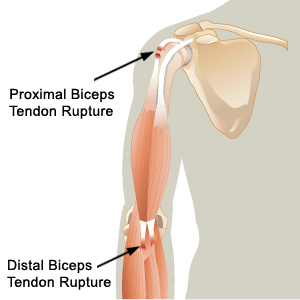Towards the end of last year, I wrote a blog about an
Achilles tendon rupture. A similar type of injury can occur in the upper arm to
the biceps tendon, where this tendon is torn off the humerus bone in the upper
arm. The biceps tendons attach the biceps muscles to the bone at the shoulder
joint (long and short head of biceps tendon) and at the elbow joint.
Causes
Biceps tendon rupture is either caused by chronic
degeneration of the tendon, or by an acute traumatic injury. Prolonged
tendinitis of the biceps tendon, as a result of excessive prolonged overhead
movements, such as swimming, make the tendon weak and more susceptible to
tearing. In biceps tendon ruptures at the shoulder, the rupture tends to occur
as a result of the tendon continually passing over the head of the humerus, causing
degeneration of the tendon. This is more commonly seen in older individuals who
have participated in activities involving repeated overhead movements of the
arm over a long period of time. Alternatively, the biceps tendon can rupture
during a traumatic event, such as heavy weightlifting.
Signs and Symptoms
An individual may hear and/or feel a snapping sensation at
the site of the tear and there is usually intense pain. The following may also
be present:
·
Skin discolouration and bruising in the upper
arm
·
A visible abnormality in the muscle belly when
the elbow is bent
·
In the case of a rupture of the long head of the
biceps tendon at the shoulder, there is an obvious “Popeye” appearance, where
the muscle belly bulges out (like Popeye when he flexes his biceps)
·
Ruptures at the elbow result in pain and
weakness near the elbow, especially when bending the elbow and turning the palm
upwards
Treatment and Management
In a complete biceps tendon rupture, surgery is required to
reattach the tendon to the bone, especially in younger, more active
individuals. A sling is then used to ensure the arm remains immobilized while
the tendon heals. Physiotherapy is required to regain range of motion in the
shoulder joint. Finally, biokinetic therapy is essential to final phase rehabilitation,
to provide stretching and strengthening exercises in order to regain full
function. In the less active population, surgery is not necessary, as adequate
function can be regained with the help of an appropriate exercise rehabilitation
programme.
References
Foundations of Athletic Training: Prevention, Assessment and
Management
